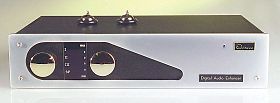Review
Thrills on a budget

Octave Electronics DAE-2 digital audio enhancer
|
Not squeezing enough out of your hi-fi system? Can't afford expensive,
imported upgrade options? Put off by those ugly, DIY solutions? SUJESH
PAVITHRAN tells you about a little box of tricks that addresses all these
issues ...
FEW locally manufactured hi-fi products created as much of a stir as
Octave Electronics' DAE-1 when it was sprung upon unsuspecting audiophiles
two years ago. Here was an odd-looking gizmo -- an unassuming, oblong black
metal box -- that cured a variety of sonic maladies in many modest systems,
without costing the earth.
The DAE-1 proved to be a hardy fella, seldom failing to please if one
could get past the spartan aesthetics, which was about the only thing that
dragged the product down. Then again, for RM850, one couldn't exactly expect
fine-art design of a DIY product, right?
Well, wrong, because, two years down the road finds Octave completely
revamping the cosmetics of the little black box, while tweaking the innards
to higher performance standards. Presenting, ladies and gentlemen, the
DAE-2, a digital audio enhancer (to give this quaint product its proper
description) for tweak-freaks.
Features
The DAE-2, as with the original, works on the basis that the analogue
output stage of many digital sources is unable to source enough current
to drive a signal across high-capacitance connecting cables into the low
impedance inputs of amps before distorting.
This impedance conversion device maintains the said output stage in
Class A, which allows the signal to drive the amp harder. Positive side
effects include the removal of high frequency harshness from the signal
source (via the roll-off effect of the DAE-2's valve input capacitors)
and a cleaning up of RF noise above 100kHz. Octave says the DAE-2, to a
higher degree than the previous product, will reveal more detail, smoothen
the overall presentation and improve staging.
Working on complaints that the DAE-1 had only a set of i/os, the upgraded
version comes with three sets of inputs and a set outputs. There's also
a spare set of RCA terminals that you can ask Octave to configure as an
extra input or output.
On the fascia are two rotary knobs to select source and gain stage,
the latter provided in 1dB steps, upto 6dB. The input stage uses two 6922/ECC88
tubes, which protrude somewhat cutely from the DAE-2's top panel, complete
with protective damper rings. The power switch is located on the side,
and a blue LED indicates the unit's operating status.
The chrome, black and gold trim is a far cry from the original box's
simplicity -- this one oozes class, despite its diminutive size, so if
looks are on your shortlist of essentials, the DAE-2 passes with flying
colours.
Performance
Sources used were a Marantz CD6000 OSE CD player and Michel Gyro Dec/Morch
DP-6/van den Hul MM1 analogue set-up (via PiPit phono stage), output through
Nordost Blue Heaven connects into Robertson Audio FortyTen 2 pre/power
combi (Straightwire Virtuoso links), which drove Monitor Audio Studio 15
loudspeakers (Flatline cables, bi-wired).
There's a considerable bit of physical headache involved in reviewing
a product like the DAE-2, chiefly because of the A/B comparisons it entailed.
Two pairs of Blue Heaven connects were used -- first, one as a direct link
from source to amp; then, in comparison, the same link was sent to the
DAE-2's inputs, and the signal was output, via the second pair of Blue
Heaven, into the amp. And I had to keep hooking and unhooking ... the things
we have to do ....
A couple of days of burning in and I was ready to chew. Yes, this certainly
works, and will do even better in a budget system. It effects noticeable,
and pleasant, changes across the frequency spectrum and in the general
presentation.
Best examples were delivered by the CD6000 OSE, which, in this system,
sounded rather congested, with a somewhat unruly bass and edgy mids and
highs. What the DAE-2 did was to clean up most of the congestion, tune
up the bass to lend the proceedings more weight, and smoothen the grain
further up, so that vocals and lead instruments blended better into the
backdrop, but without losing focus.
At the minimum gain setting, things were tightly controlled, with a
sound stage that's very even -- push the knob to max, and you'll hear a
more upfront delivery, but without any loss of control.
Similar results, although to a lesser degree, could be observed when
I switched to the turntable -- most marked was the way the bass sounded
tauter, and the mids, a tad more beguiling. Then again, the Michel set-up
has less sonic discrepancies than the Marantz.
Back to the Marantz, and the DAE-2 served to allow more presence in
the delivery, allowing more detail to emerge while ironing out the harder
edges of the spectrum. I certainly can imagine this box working wonders
in budget CD players -- I'm also assured it works wonderfully when linked
between an Astro decoder and amp.
Conclusion
Well, Octave appears to have done it again -- despite the RM100 increase
in price, the DAE-2 represents very good value for money. Now, before you
go about wanting to upgrade your CD player, try a bit of DAE tweakery first
... you won't be disappointed.
Model: Octave Electronics DAE-2 digital audio enhancer
Price: RM950
Manufactured/distributed by Octave Electronics (03-7783-7939), 81
Jalan 1/12, 46000 Petaling Jaya, Selangor / Website: http://octave-electronics.com
For: Smoothens, cleans and tightens the overall results; adds
a dash of musicality to the proceedings; cool looks; price.
Against: Those protruding tubes have suicide potential!
|